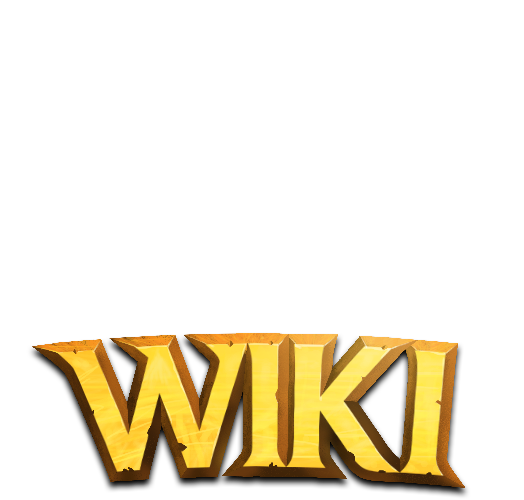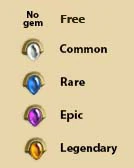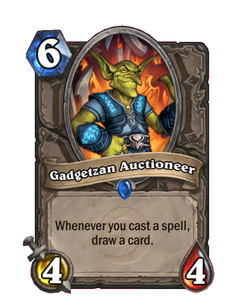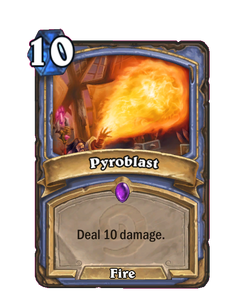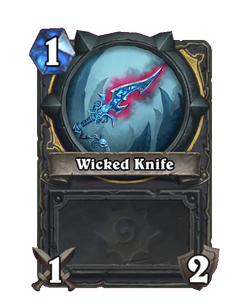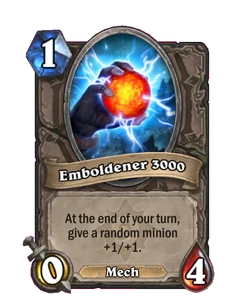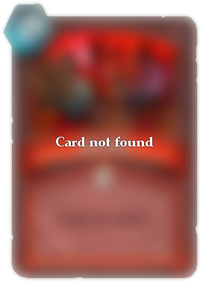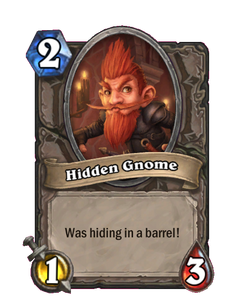Cards are the basic pieces that make up the game of Hearthstone. Each card represents an action that the player can take by playing that card. There are three main types of cards: spell cards, weapon cards and minion cards. Cards can be selected for use in a game by including them in a custom deck. Each deck is composed of 30 cards. As of Whispers of the Old Gods, Hearthstone features 1053 fully playable cards, of which 877 can be collected by players. The game also features myriad special cards available only in specific boss encounters or Tavern Brawl events, which cannot be collected by players.
Each card features a mana cost in the top-left corner, which indicates the amount of mana that must be expended to play that card, typically ranging from 0 to 10 mana. (A few cards such as Molten Giant cost more, with the cost being reduced depending on the state of the game.) Each card also features a portrait, a title, and a main card text pane below that. For minion and weapon cards, the text describes any special effects or abilities possessed, while for spells the text describes the effect of playing that card. Card text on minions can be removed with Silence effects. Minion cards feature an Attack value in the bottom-left corner, and a Health value in the bottom-right corner. Equipment cards similarly feature an Attack value in the bottom-left corner, with a Durability value in the bottom-right corner. Spell cards feature only a mana cost.
Categories
Cards are categorised by rarity, class and set. Five rarities exist - free, common, rare, epic and legendary - with higher rarities typically being more powerful, but being harder to find and more expensive to craft. Most cards are also available in a golden version, a purely aesthetic enhancement. While most cards are available to heroes of all classes, many are exclusive to a specific class.
Cards which can be obtained by players are also divided into several sets - Basic, Classic, Reward, Promo, and several expansion and adventure sets - reflecting how the card can be obtained, and determining whether it is valid in Standard format play. Most Basic cards are automatically included in players' collection, while half of all class-specific Basic cards can be obtained through levelling a hero of that class to level 10. Classic cards, and cards from expansion sets such as Goblins vs Gnomes and The Grand Tournament, are available primarily through crafting or opening corresponding card packs. Cards from adventure sets such as Naxxramas and League of Explorers are acquired through defeating bosses in the corresponding adventure. Promo cards can only be obtained through participating in the related promotion. The hypothetical boss set and Tavern Brawl set are used to categorise cards used by bosses and cards provided for players during Tavern Brawls, neither of which are collectible, and feature only in their respective areas of play.
Collecting cards
Each player's collection can be viewed and inspected through the My Collection screen. Each player starts the game with a substantial collection of basic cards, including a large range of neutral minion cards, and 5 basic cards specific to each class.
Players can receive new cards in a number of ways:
- by leveling heroes
- from card packs, which may be bought with real money or with gold, or rewarded from Arena wins or certain unique quests
- by crafting a new card from Arcane Dust
- by defeating bosses and completing wings in adventures
- a few specific cards can be obtained as rewards for completing unique quests, or as part of promotions
Players can include up to 2 of any individual card in a single deck, with the exception of legendary cards, which can only be included once in each deck. Extra cards can be disenchanted for Arcane Dust, a resource used in the creation of cards, with rarer cards costing much more than the more common cards to craft. Players are not able to trade cards with other players.
Card backs
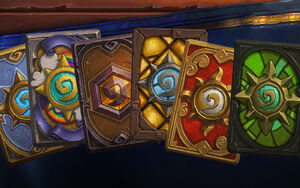
An example of alternate card backs that can or could have been collected
- Main article: Card back
Card backs are a Hearthstone feature which allows players to replace the standard design on the reverse of their cards with alternate designs. Players can earn alternate card backs through fulfilling various criteria, such as reaching Rank 20 in a season of Ranked play, or completing certain quests. Several different card backs are available to collect, with each offering a distinct animated design. Players can choose which available card back to use, with the selected design displayed in-game on the backs of the player's cards, visible to both the player and their opponent. Card backs are purely decorative and do not affect gameplay in any way.
Card art
- Main article: Card art
The art used on Hearthstone's cards is one of the most striking and memorable aspects of the game's artistic design. These small yet detailed images are usually taken from far larger pieces of art, with only a small section used in the game. The majority of card art for Hearthstone was previously used for the World of Warcraft Trading Card Game, but some pieces were specially commissioned for the game, such as that for ![]() Anduin Wrynn.
Anduin Wrynn.
Original cards
- Main article: Original cards in Hearthstone
While the majority of the characters, abilities and weapons in Hearthstone come from World of Warcraft, or the Warcraft universe in general, some have made their debut with Hearthstone itself. Hearthstone has also introduced numerous new character types, and titles for existing types.
Minion cards
- Main article: Minion
Minions are permanent creatures on the battlefield that will fight for their hero. Minion cards can be recognized by their Attack (a number displayed on a yellow sword, in the bottom left corner) and Health (a number displayed on a red blood drop, in the bottom right corner). Minions are controlled by the player who summoned them, and can be commanded to attack their opponent's minions, or the opposing hero, while minions with Taunt can act as tanks, preventing the opponent's forces from attacking the hero directly with melee attacks until that minion is destroyed. Minions are a major element in battles between heroes, and are usually responsible for the majority of all damage dealt in a game. Minions are the most common type of card.
For a full list of minion cards, see Minion.
Spell cards
- Main article: Spell
Spell cards are cards that can be played to trigger a one time effect or ability, described in the card's text. In contrast to a minion or weapon card, a spell card will expire immediately after it has been used. Spell cards do not have an Attack or Health value, and are the second most common type of card.
For a full list of spell cards, see Spell.
Weapon cards
- Main article: Weapon
Weapons are special cards which can be equipped by heroes. Each weapon has an Attack value and a Durability value. Each hero can only equip one weapon at a time, and equipping a new weapon will destroy the old one. Attacking using a weapon deals damage equal to its Attack, and reduces its Durability by 1. When a weapon's Durability is reduced to zero, the weapon will be destroyed. All classes except druids, priests and mages have weapons available to them, with rogues, paladins and warriors generally considered to have the greatest synergy with weapons. Weapons are the least common type of card.
For a full list of weapon cards, see Weapon.
Template:Equipment card small table
Uncollectible cards
- Main article: Uncollectible
Uncollectible cards are cards which although available in-game cannot be collected by players. While these cards are often playable and obtainable by players in the course of a match, they cannot be added to players' collections or permanently acquired. Most uncollectible cards are produced by other cards.
Boss cards
- Main article: Boss card
Boss cards are cards used by bosses in adventures such as Curse of Naxxramas and during the game's tutorial. They are not available in normal play.
Removed cards
- Main article: Removed card
Removed cards are valid Hearthstone cards which have been removed from play. These cards can no longer be collected or found in-game. All of the current list of removed cards were removed during the game's alpha or closed beta test phases.
Unavailable cards are cards which although appearing in the game in some way are never available for players to use.
Credits cards
- Main article: Credits card
Credits cards are non-playable cards that depict members of the Hearthstone development team. These cards are not found in play, but are displayed during the game's credits, accessed through the options button from the game's main menu. There are 17 credits cards, depicting the 15 members of Team 5, and the game's two executive producers.
Debug and system cards
- Main article: Debug card
Debug cards are cards designed for testing and debugging Hearthstone. Designed for use in a specific testing environment, these cards often feature outlandish powers, and are not available to players. System cards are very similar non-available cards used by the game system.
